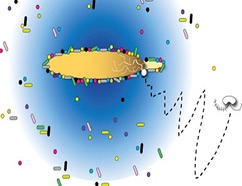Welcome to Cornell University’s vermicompost research page. The short 9-minute film “Vermicompost: a Living Soil Amendment” is a general introduction to the vermicomposting process as a technology that transforms organic wastes into resources and the uses of vermicompost for plant nutrient management and the suppression of plant diseases. The film can be viewed streaming (YouTube below) and the higher resolution version is available as a free download. More detailed reports from a series of studies carried out at Cornell in the Departments of Plant Pathology and Plant-Microbe Biology and Horticulture are linked below. Teaching resources and links to other vermicompost related sites are also included.
A 3-minute version of this video "Vermicompost and Pythium Suppression" won the Grand Prize in the American Phytopathological Society's Office of Public Relations and Outreach 2010 contest (click here) and second prize in the ChloroFilms plant video contest (click here).
|
||
http://www.youtube.com/watch?v=JFGQR5ERaPQ
Video can also be downloaded here.
Our project team found limited benefits associated with direct soil applications of vermicompost. However, we did find that vermicompost can be an important component of potting media for producing vegetable transplants without synthetic fertilizers. Temperature is a significant factor in the performance of potting media containing vermicompost and we investigated optimal temperature ranges for a variety of vegetable crops. We found that vermicompost from a specific facility protects cucumbers from Pythium aphanidermatum, a seed-infecting pathogen. Through an ongoing project, we’re investigating the microbial mechanisms that prevent infection from occurring to increase our understanding of the biological control of plant diseases.
- Vermicompost use for plant nutrient management
- On-farm field and greenhouse trials
- Cornell field and greenhouse trials
- Tomato
- Cabbage
- Temperature optimization trials for vegetable transplants
- Transplant media for organic tomato production and rhizosphere microbial communities
- For additional information on vegetable production:
- Suppression of plant disease with vermicompost
- Public outreach posters: Development of biocontrol products from vermicomposted dairy manure
- American Society for Phytopathology presentation 2008
- Ecology and Evolution of Infectious Disease Conference 2010
- Organic Farming Research Foundation
- Mid-West Organic and Sustainable Education Service (MOSES) 2010
- Zoospore behavior
- 1-minute video clip, view on YouTube
- Teaching resources
- Vermicompost lab exercises for college level soil science course
- Additional video microscopy footage of vermicompost microarthropods and earthworms
- Vermicompost research in the news
- Business keeps worms 'fat, dumb and happy' - DemocratandChronicle.com
- Worm power putting earthworms to work - InnovationTrail.org
- Extension resources
- Appropriate Technology Transfer to Rural Areas (ATTRA) 2010 Vermicomposting fact sheet (http://attra.ncat.org/attra-pub/vermicomp.html) This fact sheet focuses on the production of worms for the bait and vermicomposting markets.
- NC State Vermicomposting Resources & Workshops page. NC State hosts an annual workshop for professional vermicomposters http://www.bae.ncsu.edu/people/professionals/sherman/).
- Cornell Waste Management Institute (CWMI) generates a broad range of extension and education resources on composting.
- Tompkins County Cornell Cooperative Extension Compost Education Program (http://ccetompkins.org/gardening/composting/compost-resources).
- Dr. Eric Nelson: Plant Pathology and Plant-Microbe Biology
- Dr. Anu Rangarajan: Department of Horticulture
- Dr. Charles Nicholson: Department of Applied Economics and Management
- Jean Bonhotal: Cornell Waste Management Institute, Soil and Crop Sciences
- Tom Herlihy: Worm Power, LLC
Funding:



